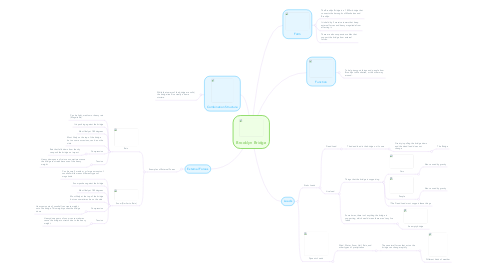
1. Combination Structure
1.1. While the towers of the bridge are solid, the bridge itself is actually a frame stucture.
2. External Forces
2.1. Examples of External Forces
2.1.1. Rain
2.1.1.1. Can be light, medium or heavy rain (Magnitude)
2.1.1.2. It is pushing against the bridge
2.1.1.3. Most likely at 180 degrees
2.1.1.4. Most likely on the top of the bridge but on some occasions, can be on the side
2.1.1.5. Compression
2.1.1.5.1. Rain that falls down from the sky can push the bridge on impact
2.1.1.6. Tension
2.1.1.6.1. Heavy downpours of rain can sometimes cause the bridge to stretch because of the heavy weight
2.1.2. Snow (Similar to Rain)
2.1.2.1. Can be small, medium, or large amounts of snowfall which means different types of magnitude
2.1.2.2. Snow pushes against the bridge
2.1.2.3. Most likely at 180 degrees
2.1.2.4. Most likely at the top of the bridge but can sometimes be on the side
2.1.2.5. Compression
2.1.2.5.1. Heavy amounts of snowfall can create weight onto the bridge. This weight pushes the bridge down
2.1.2.6. Tension
2.1.2.6.1. Heavy downpours of snow can sometimes cause the bridge to stretch due to the heavy weight
3. Form
3.1. The Brooklyn Bridge is a 1 825m bridge that connects the boroughs of Manhattan and Brooklyn.
3.2. It is held by 2 massive towers that keep external forces and heavy magnitude from affecting it.
3.3. There are also suspension cables that support the bridge from external forces.
4. Function
4.1. To help transport things and people from Brooklyn to Manhattan, or the other way around.
5. Loads
5.1. Static Loads
5.1.1. Dead Load
5.1.1.1. The dead load is the bridge on it's own
5.1.1.1.1. Gravity is pulling the bridge down and the dead load does not change
5.1.2. Live load
5.1.2.1. Things that the bridge is supporting
5.1.2.1.1. Cars
5.1.2.1.2. People
5.1.2.1.3. ^The Dead Load must support these things
5.1.2.2. Sometimes, there isn't anything the bridge is supporting, which would mean there aren't any live loads
5.1.2.2.1. An empty bridge
5.2. Dynamic Loads
5.2.1. Wind, Water, Snow, Hail, Rain, and other types of precipitation
5.2.1.1. These natural forces that act on the bridge can change rapidly
5.2.1.1.1. Different kinds of weather

